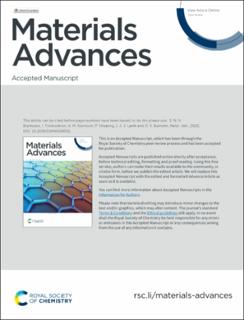| dc.contributor.author | Bryntesen, Silje Nornes | |
| dc.contributor.author | Tolstorebrov, Ignat | |
| dc.contributor.author | Svensson, Ann Mari | |
| dc.contributor.author | Shearing, Paul Robert | |
| dc.contributor.author | Lamb, Jacob Joseph | |
| dc.contributor.author | Burheim, Odne Stokke | |
| dc.date.accessioned | 2022-12-27T13:38:43Z | |
| dc.date.available | 2022-12-27T13:38:43Z | |
| dc.date.created | 2022-11-11T08:14:09Z | |
| dc.date.issued | 2022 | |
| dc.identifier.issn | 2633-5409 | |
| dc.identifier.uri | https://hdl.handle.net/11250/3039562 | |
| dc.description.abstract | By enabling water-based cathode processing, the energy-intensive N-methyl-2-pyrrolidone (NMP) recovery step can be eliminated, reducing the cost and environmental impact of LIBs. Aqueous processing of high capacity Ni-containing LiNixMn1−x−yCoyO2 (NMC) cathodes is problematic due to lithium-ion(Li+) leaching, corrosion of the aluminum (Al) current collector, and the lack of aqueous soluble bio-derived binders. The present study investigates the potential of substituting and fully replacing the commonly used polyvinylidene fluoride (PVDF) and carboxymethyl cellulose (CMC) binders with abundant, bio-derived kraft lignin. This paper gives a holistic overview of the optimal conditions when employing these binders. For the first time, we demonstrate that NMC111 cathodes of comparable specific capacities to NMP/PVDF-based ones over 100 cycles or at high C-rates (5C) can be formulated in water using lignin or CMC/lignin as binder materials. Cyclic voltammetry (CV) revealed that kraft lignin undergoes a redox reaction with the electrolyte between 2.8 and 4.5 V, which diminishes upon subsequent cycles. Differential scanning calorimetry (DSC) revealed that lignin is thermally stable up to 152 °C. Rheology measurements showed that replacing NMP with water allows for a solvent reduction. The cathodes fabricated using an aqueous slurry should be dried at 50 °C, as extensive surface cracks detected using scanning electron microscopy (SEM) diminish. Li+ leaching from NMC111 and NaOH species from kraft lignin caused an increase in pH during aqueous slurry fabrication. A carbon-coated Al foil (C-Al) prevented Al corrosion and increased the lignin cathode's mechanical strength revealing lignin's exceptional binding abilities to carbon. The electrolyte wettability decreased for calendered lignin-containing cathodes with low porosity and a large carbon black/lignin matrix. | en_US |
| dc.language.iso | eng | en_US |
| dc.publisher | Royal Society of Chemistry | en_US |
| dc.rights | Navngivelse 4.0 Internasjonal | * |
| dc.rights.uri | http://creativecommons.org/licenses/by/4.0/deed.no | * |
| dc.title | Introducing Lignin as a Binder Material for the Aqueous Production of NMC Cathodes for Li-ion Batteries | en_US |
| dc.title.alternative | Introducing Lignin as a Binder Material for the Aqueous Production of NMC Cathodes for Li-ion Batteries | en_US |
| dc.type | Peer reviewed | en_US |
| dc.type | Journal article | en_US |
| dc.description.version | publishedVersion | en_US |
| dc.source.journal | Materials Advances | en_US |
| dc.identifier.doi | 10.1039/D2MA00850E | |
| dc.identifier.cristin | 2072197 | |
| cristin.ispublished | true | |
| cristin.fulltext | original | |
| cristin.qualitycode | 1 | |

